Emma Minnie Boyd, The Window Seat, 1887, oil on canvas, 31 x 41 cm, National Gallery of Victoria.
A Reading Memo
Rex Butler
I went to the National Gallery of Victoria to look for paintings of people reading. It could be anyone, but it’s almost invariably women.
I was hoping for at least one, so that I could write this review, but there were more than I remembered.
There in the Symbolism room—you know, the one with Rupert Bunny’s Sea Idyll (1891), John Longstaff’s The Sirens (1892) and Bertram Mackennal’s Circe (1893)—there was Emma Minnie Boyd’s The Window Seat (1887), which shows a young woman in a well-upholstered interior gazing down at a book in her lap with the great Australian outdoors visible through the window. (The work is actually set in her and her husband Arthur Merric Boyd’s posh house on Inkerman Street in Balaclava.) There is also Charles Wheeler’s The Poem (1910), which depicts two women, one sitting on a chair and the other leaning against it reading a poem, along with the daughter of one of the women reading alongside her. There is even Arthur Loureiro’s The Young Artist (1888), if you want to count that—and I do—which portrays a young female artist mixing paints on her palette staring intently out into space before starting work.
Then out through the doorway of the Symbolist gallery and into the one featuring the Australian expatriates—a nice hang—we can see Agnes Goodsir’s Woman Reading (1915), which records, I’m pretty sure, Goodsir’s long-term model and lover Rachel Dunn with book propped open. Goodsir loved painting Dunn, or Cherry as she was known, reading, and there is an even better one, The Chinese Skirt (1933) at the Art Gallery of New South Wales, which shows her looking considerably more relaxed with her boyish New Look haircut reflected in the mirror of her drawing room table behind her.
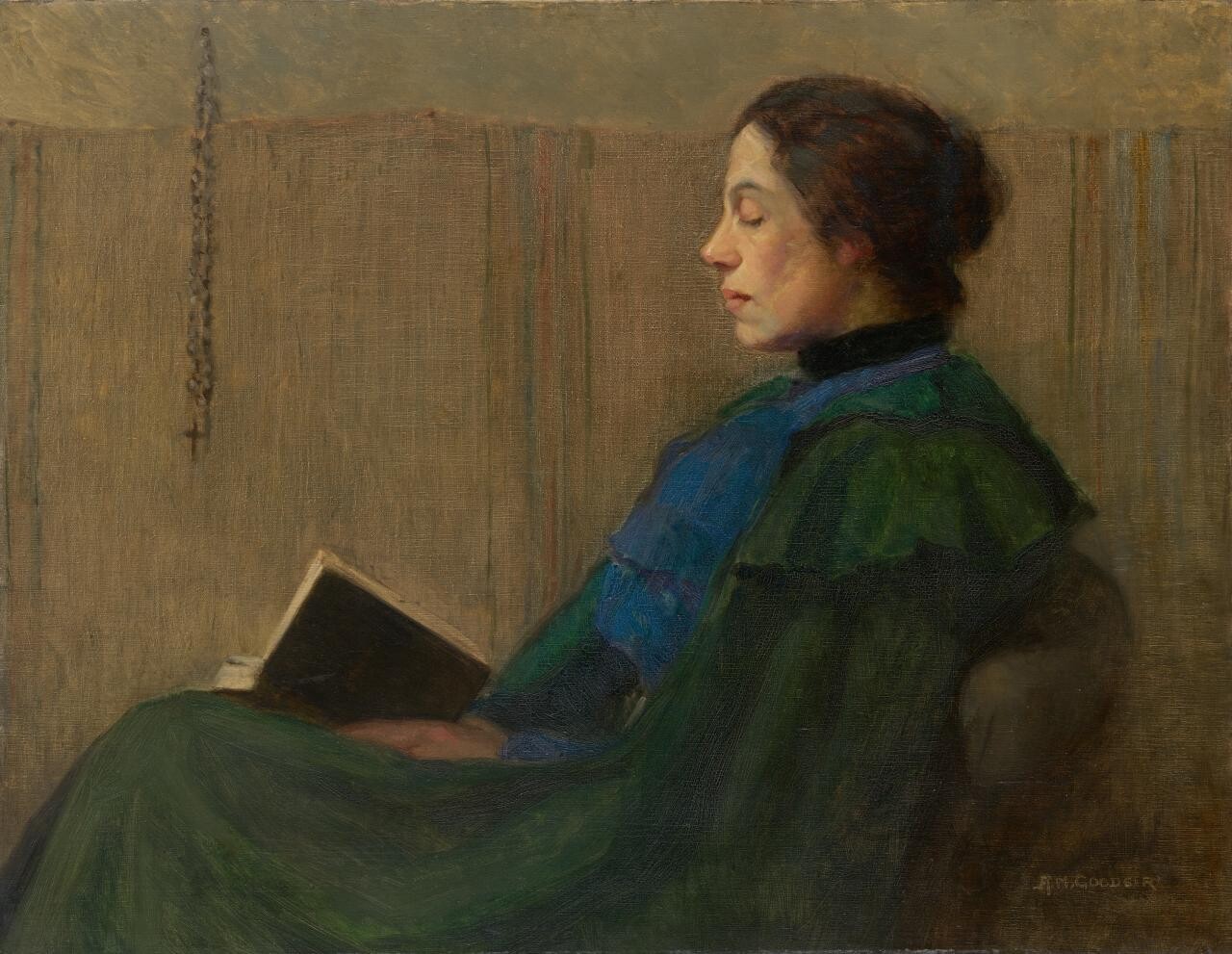
Agnes Goodsir, Woman Reading, c. 1915, oil on canvas, 71 × 91.5 cm, National Gallery of Victoria.
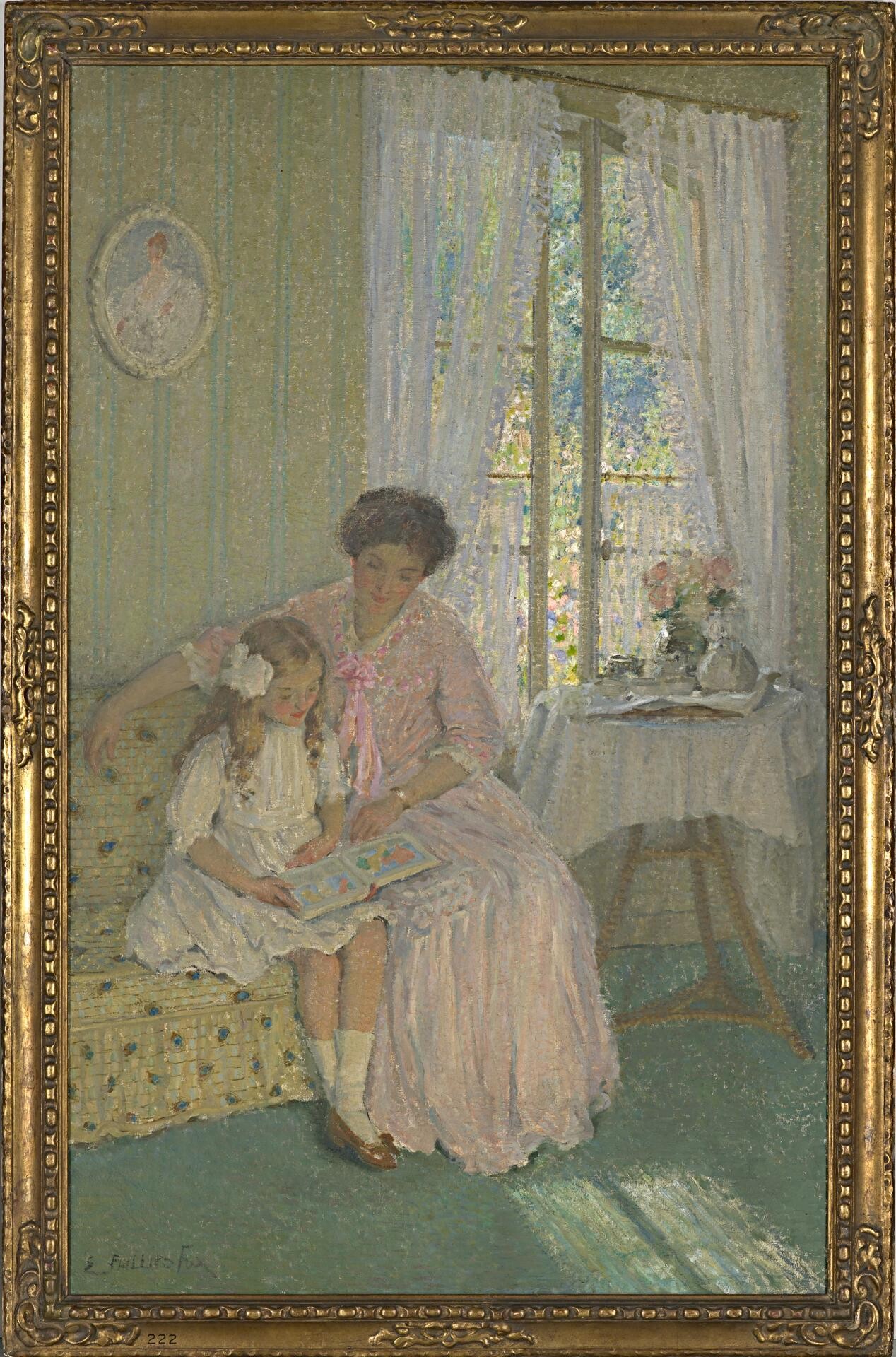
E. Phillips Fox, The Lesson, 1912, oil on canvas, 183.6 × 112.6 cm, National Gallery of Victoria.
Finally, also in the expatriates gallery, there is E. Phillips Fox’s The Lesson (1912)—his wife, Ethel Carrick Fox, is having a huge and well-deserved retrospective at the National Gallery of Australia at the moment—which shows a mother and daughter (I don’t think it’s a governess, they look too much alike) reading a picture book together, the mother in a pink cotton dress with bow and the daughter in a white muslin dress with a flower in her hair.
It’s a considerable art-historical topic, women reading. There are all the classic examples, like Botticelli’s Madonna of the Book (1480), Vermeer’s Woman in Blue Reading a Letter (1662) and Fragonard’s Young Girl Reading (1776), but the idea really gets going with the women Impressionists. There’s Berthe Morisot’s portrait of her sister Edma, Reading with Green Umbrella (1873), and then there’s Mary Cassatt’s long sequence of women reading, Reading ‘Le Figaro’ (1878), Mrs Cassatt Reading to Her Grandchildren (1880) and Young Girl Reading (1894). And altogether, to take Boyd’s The Window Seat as an example, we might speak of a certain interior “feminine” space of introspection and reflection as opposed to the external “masculine” space of bushrangers and sheepshearers on the other side of the window.
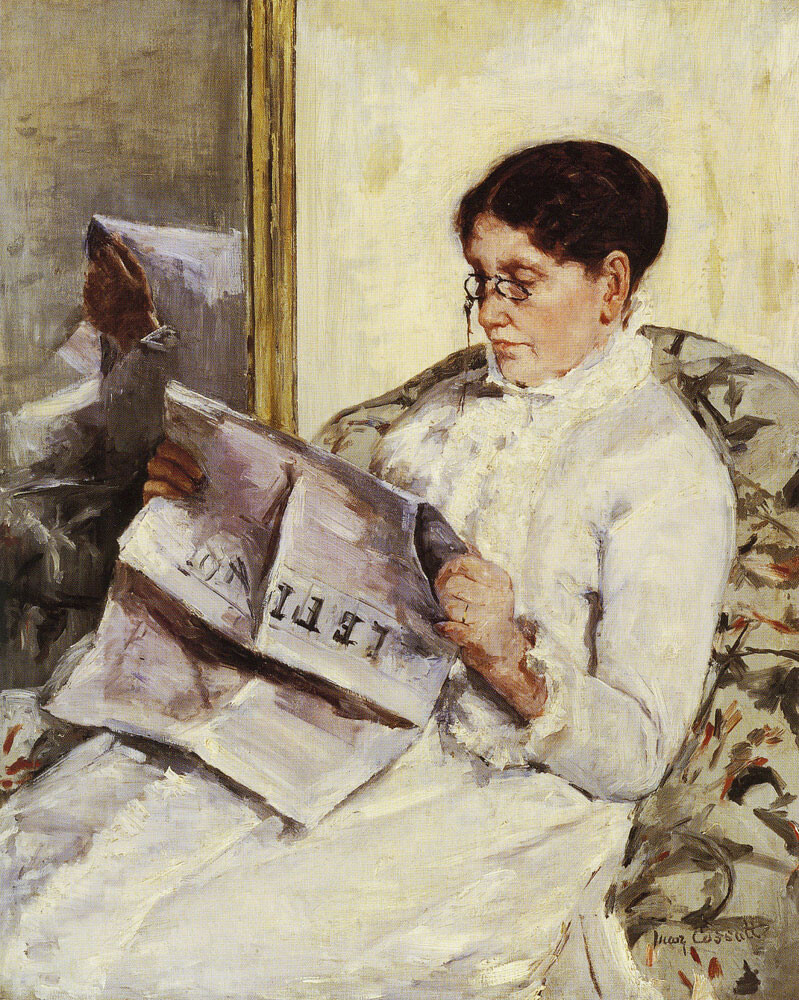
Mary Cassatt, Reading ‘Le Figaro’, 1878, oil on canvas, 104 x 83.7 cm. Private collection.
Maybe the best-known of the numerous writings on the topic is James Conlon’s “Men Reading Women Reading: Interpreting Images of Women Reading” (2005), which offers a broadly sympathetic account of the admittedly predominantly male depictions of women reading. But there are lots of dissenting counter-readings that object to the idea of men depicting women reading, such as Kirsten’s (no surname) Substack post “Paintings of Women Reading in Suspicious Abundance” (2024), in which she writes, “In the expansive history of women being denied literacy, the abundance of paintings featuring women reading can seem like a rebellion, even if a quiet one. That is, until you realise that most of these are made by men.” But this is perhaps to leave open the question of what these depictions might mean when they are actually made by women.
What really prompted me to go back to the NGV to look for paintings of people reading, however, apart from the fact that no one else from Memo was up for writing the first review of the year—shame on you, younger generation—was a photo an ex-student sent me. It’s a sort of challenge I set my students: to send me a photo of one of the famous works of art we discuss in class when they actually see it in the flesh. This one was of Picasso’s Les Demoiselles d’Avignon (1907) at the Museum of Modern Art in New York, on which we spend some one and a half hours, including showing that famous clip from Hannah Gadsby’s Nanette, in which they say of Picasso’s painting, “from above, from below, inside, out. But, tell me, are any of these perspectives a woman’s?”
But this photo—thanks, Ella—is amazing. It shows a packed roomful of people firing off shots of Demoiselles from their phones. No one is any longer looking at the painting—the room is so crowded, maybe they can’t. They’re just taking photos of it to prove that they were there with it, in some kind of modern equivalent to visiting a religious icon (except without any of the knee-bending and veneration).
And that’s when I thought about those paintings of people reading. Because today they can be seen to be speaking not merely about some supposedly different “feminine” space or the gender politics associated with the act of depiction, but about the whole question of whether we look any more at works of art. In other words, those women quietly and undistractedly reading their books are perhaps images of how the paintings once understood we might be looking at them. Put simply, it’s us up there in those pictures, whether we are male or female, looking at ourselves looking at them.
Except that now it’s all over. We don’t look, we don’t read, we don’t stand before the work in quiet contemplation. We just take a picture and move on. Or maybe—and here’s where things become a little confusing—we don’t look anymore but only read, by which we might mean we only see what we want to see. (And if we wanted an image of this, take a look at Bessie Davidson’s Girl in the Mirror (1914), also in the expatriates gallery, in which a young woman looks at a reflection of herself in a mirror.)
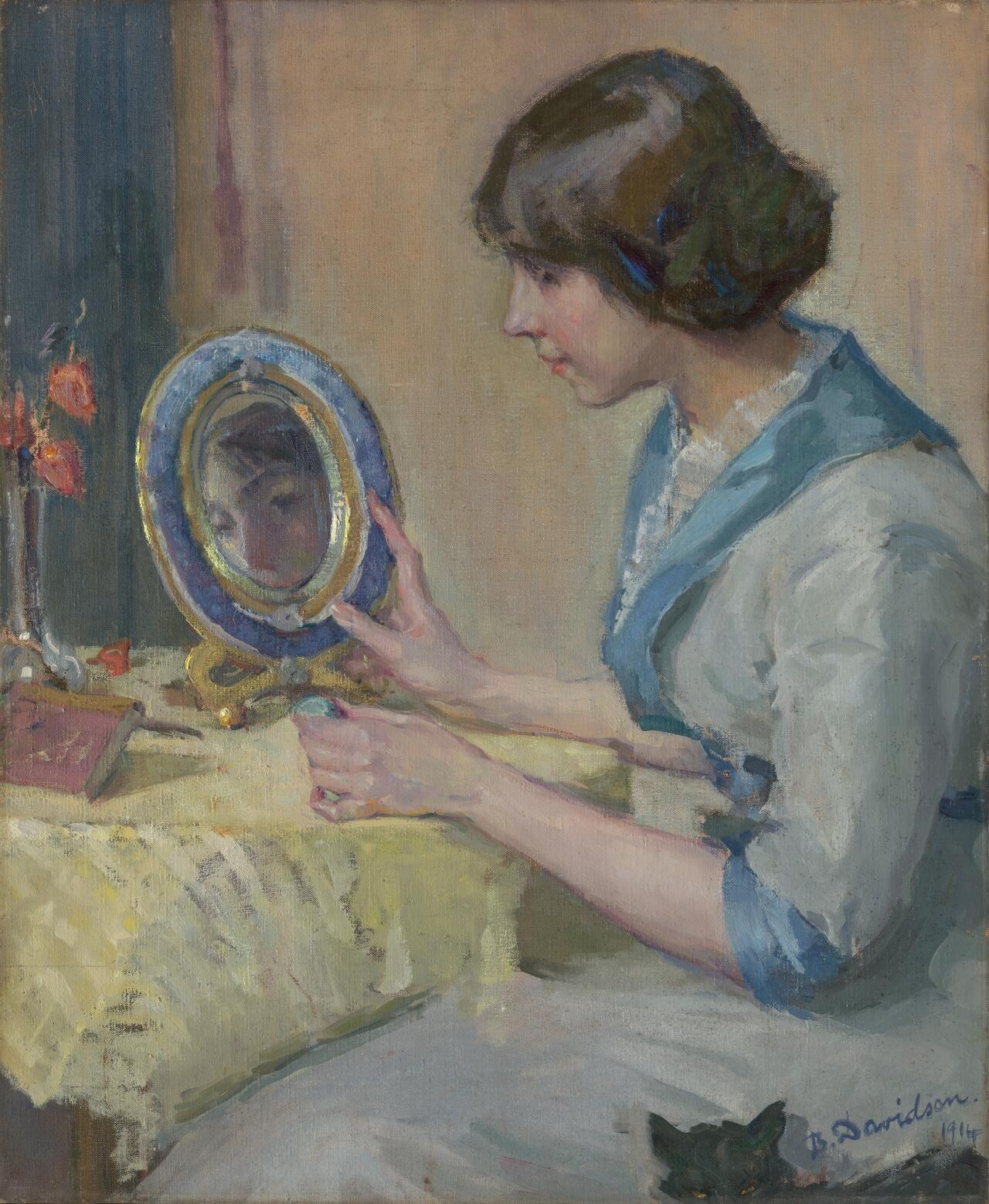
Bessie Davidson, Girl in the Mirror (Jeune fille au miroir), 1914, oil on canvas, 73 x 60 cm, National Gallery of Victoria.
There’s a terrific essay, published just last month, by the cultural critic Simon During, “The Conservative Turn in Literary Studies,” in which he advocates—or at least speaks of the recent advocacy of—”close reading” in literary studies. This involves a renewed push for “close reading”—and During admits that it can sound conservative, although he also says we should not be afraid of this—against the “critical” reading of texts in the name of some supposedly progressive social agenda. What would be at stake in or what would be implied by this “close reading”? This is where things get a little tricky. During speaks of such things as—and it is to cast back to the very (Anglo) origins of the discipline—the assertion of quality, the openness to ambiguity and the respect for truth. He can see all of this being lost in the relentless commercialisation of universities, the collapse of intellectual authority and the rise of authoritarian populism.
I’d agree with most of what During says. It’s a very well thought-out and reasoned piece, and I’m not even sure how I’d (want to) disagree with it. But it was a marvellous coincidence that a friend sent it for me to read—which I did, via my iPhone, of course—at the very moment I’d decided to write about those paintings of people reading at the NGV.
There is something brilliantly contrarian today about those paintings of women reading: heads down, absorbed, unaware of being looked at and off their phones. They—if only we could live up to their promise—offer a moment of respite, of a non-distracted distraction, of the possibility of something new popping into our heads. Looking at them, we are opened up to another, exactly like reading a book.
It’s hopefully a little like how you feel reading this, or another Memo review every week. I’d like to think of those paintings not just as depictions of the people looking at them, but of you reading this—or anything. I’m not sure if the device on which you are reading this has the sometimes description “Suggested reading time 15 minutes,” as though to warn you of the commitment ahead. It’d certainly be amusing if galleries in the future started adding that to their didactics, telling you how long it was expected you would take to look at the work.
But somehow as I looked at those women reading in the gallery that afternoon, spending time with them, and admittedly more than I usually do, knowing that I would be writing about them, I felt that I could identify with them. I seemed to sense what they were going through in their self-possession and solitude. Maybe I was forcing things a little too much, maybe I was “reading” the works, using them for my own ends, knowing I was going to write about them, and not letting them speak for themselves. But it didn’t feel like that and I didn’t know exactly what I was going to say.
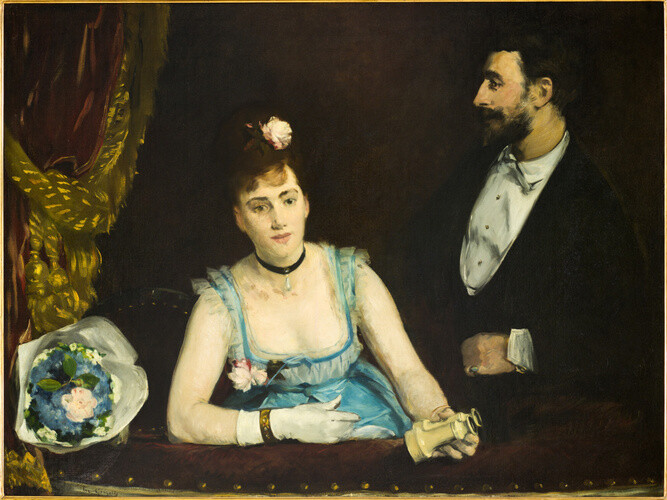
Eva Gonzalès, A Loge at the Théâtre des Italiens, 1874, oil on canvas, 97.7 x 130 cm, Musée d’Orsay, Paris.
Perhaps the thing to do now would be to make a series of paintings—no, better photographs—of people on their phones: not seated looking down, but driving a car, crossing a road, in a movie just before the lights go down. (Put a phone and not opera glasses in the hands of the woman in Cassatt’s In the Loge (1878) and you get the idea, or maybe the woman staring distractedly out in Eva Gonzalès’ A Loge at the Théâtre des Italiens (1874) might be a better candidate.) But likely some hipster artist has already done all that.
Happy reading of Memo in 2025. Is it not this review or another that the young woman in Boyd’s The Window Seat is opening up just now on her tablet mid-Saturday morning in not-quite-so-leafy anymore Balaclava? Hopefully so.
Rex Butler teaches Art History in the Faculty of Art Design and Architecture at Monash University. VIC.